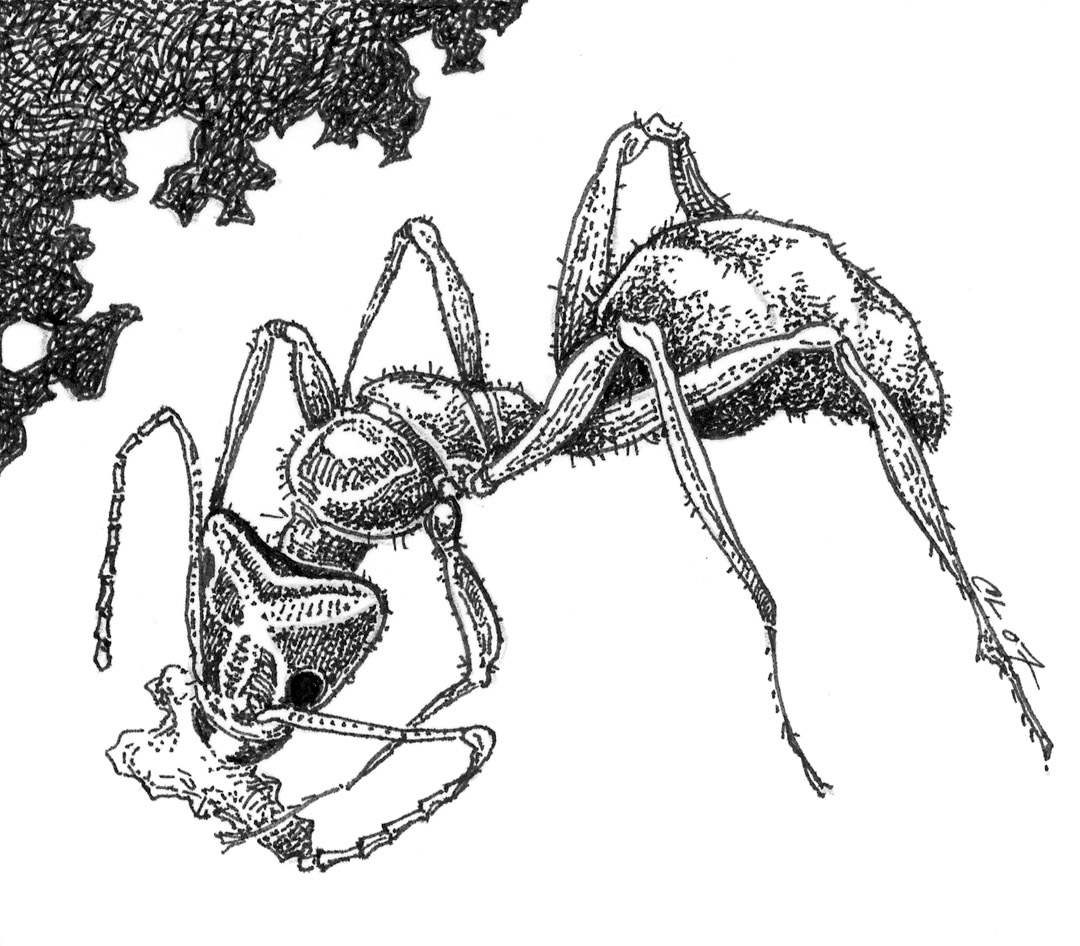

Contributor
- Topics: Archive

Ants…As Allies?
In Aesop’s fable, the ant is held up as a paragon of industry. Carpenters, weavers, gardeners, harvesters, drivers, and honeypot ants all uphold the image of the hard-working cooperative society. The ant realm is endlessly fascinating, as the plethora of books and nature programs on the subject attests. When ants invade our homes, however, our admiration ceases, and we quickly perceive them to be pests. While few of us welcome ants as houseguests, in the garden most ant species are beneficial. There are probably tens of thousands of ants in the average West Coast landscape, mostly functioning as scavengers.
In gardens, pest ants are usually those feeding on honeydew, produced by homopteran pests such as aphids and mealybugs. On plants such as citrus, ants and homopterans are a problem, but in many cases, the role of ants is not easily determined. For instance, some ant species that are principally beneficial sometimes supplement their diet with honeydew when other resources are scarce. Some ants that are pests in houses, such as carpenter ants, provide a service in the landscape, where they help break down dead wood. Observation is the key to determining whether ants are behaving as pests or benefactors in the garden.
Ants are far more diverse than many of us realize. One can find over one hundred species in the San Francisco Bay area alone. Although many species are widespread, others occur in a limited region. Many species require specific conditions; those found in cool damp parts of the Pacific Northwest are quite different from those in arid parts of Southern California. Some relatively common species are rarely noticed. Honeypot ants, for instance, live in many arid and semi-arid areas, but most people have never seen them, since the unusual workers, their bellies full of nectar, are found underground.
One observer described an ant colony as a factory inside a fortress. Ants are highly evolved social insects; duties are divided among castes of adults, which typically include reproductive queens, sterile female workers (sometimes of several different castes, each with its assigned task), and short-lived males (whose only role is reproduction). The nuptial flight is the poetic name for the mating that occurs when the winged females and males emerge from the nest. Unlike bees, some ant species have multiple queens, which may explain the difficulty in eliminating colonies. Ant colonies have a complex system of communication, mediated by pheromones (chemicals) that they exude. Instructions for trail construction, location of food sources, alarm, and recognition of colony mates are controlled by pheromones. Ants can quickly mobilize workers for defense, one of the reasons for their success.

Ecologically, ants are an important group of insects. Many ants are scavengers; depending upon the species, they may also feed on plants, invertebrates, fungi, or a combination of these. They have a role in the aeration of soil, nutrient cycling, pollination, distribution of seeds, and pest regulation. Some plants have evolved extra-floral nectaries, and special “packets” of food to attract ants, which then aggressively attack any herbivore so foolish as to approach. Some tropical species of Acacia provide prefabricated homes (domatia) for ants. In the Pacific Northwest, a mutualism exists in some fruit trees, such as peaches and cherries, that have extra-floral nectaries supporting ants.
It is well known among gardeners that ants protect aphids from many of their natural enemies. Yet, some of the most useful ants, from a biological control perspective, are species that use honeydew as a resource when other food sources are scarce. This poses a dilemma for the gardener who would prefer to not have mealybugs, ants, or the sooty mold that accompanies them in their citrus! It may be wise to tolerate a few aphids elsewhere in the garden, as they will be an alternative food source for many valuable garden predators, in addition to ants. Beware: the most common species that feeds on honeydew in California is the Argentine ant, an introduced species that aggressively defends its territory against native ants, often completely eliminating the native species.
Ironically, the earliest known use of biological control, practiced for over 1,700 years, employed ants to protect citrus from pest insects. Bamboo bridges were provided so that ants could go from tree to tree. The Chinese introduced weaver ants to the citrus orchards to protect the trees from herbivores, a technique also in use in the Mekong Delta of Vietnam. Studies on biological control by ants have also been conducted in coconut and cacao plantations. Native fire ants are major predators of cotton pests. California gray ants are known to prey on peach twig borer.
When ants behave as garden pests, management may require a combination of methods. Do all you can to prevent the arrival of Argentine ants, as it will be impossible to eliminate them once they have invaded your garden. Check all potted plants for ant colonies before bringing them home; this is especially important in Oregon and north, where Argentine ants are not currently a problem. Avoid planting trees that attract homopterans next to buildings. Concentrate control efforts in the late winter and early spring, when they will have the greatest effect.
Above all, I try to follow the advice, perhaps apocryphal, of biologist EO Wilson of Harvard, who has devoted his life to the study of ants. When asked his opinion on what to do about ants in the house, he is reputed to have answered: “provide some crumbs and get out a magnifying glass!”

In a Nutshell
Popular Name:
Ants
Scientific Name:
Order: Hymenoptera (bees, ants, and wasps). While there are many families of bees and wasps, all ants are in the Family: Formicidae.
Common Species:
Native species include: velvety tree ant (Liometopum occidentale), carpenter ant (Camponotus spp.), honeypot ant (Myrmecocystus spp.), California gray ant and related species (Formica spp.). Introduced species: pavement ant (Tetramorium caespitum); pharaoh ant (Monomorium pharaonis), generally found in houses; red imported fire ant (Solenopsis invicta), now established in Southern California; Argentine ant (Linepithema humile), found in low-lying and urban areas of California.
Distribution:
12,000 species worldwide. Over 300 species in the Pacific Northwest alone (fewer than a dozen are major pests.)
Life Cycle:
Holometabolous (a complete metamorphosis from egg to larva, pupa, and adult.)
Appearance:
Eggs: microscopic. Larvae: maggot-like. Pupae: usually white, sometimes grey. Adults: under an inch long, usually wingless; black, brown, red, yellow, or combinations of these colors.
Life Span:
Varies among species and among castes. Most workers live only a few weeks; carpenter ant workers can live up to seven years. The tiny pharaoh ant queen may live only a few months.
Diet:
Varies among species: honeydew and nectar, live and dead insects, insect eggs, seeds, fungus, decomposing organic tissue.
Favorite Plants:
Plants that host aphids or other homopterans, or offer extra-floral nectaries. Ants sometimes visit flowers for nectar. A few species nest in hollow stems or in dead wood.
Benefits:
Biological control of some pests, soil aeration, nutrient cycling, pollination, seed dispersal.
Problems:
May damage plants; bite, sting, or pester humans and other organisms; or infest homes. Control with bait stations (boric acid formulations are slow but effective) and commercial sticky barriers on trees. Outdoor baits will sometimes effectively draw ants out of homes; conversely, placing bait indoors may draw ants into the house. Submerge potted plants for twenty minutes in solution of insecticidal soap and water at a rate of one or two tablespoons of soap per quart of water.
Interesting Facts:
Termites, sometimes called white ants, are not even closely related to true ants. Distinguish ants by their constricted waists and elbowed antennae. When you notice ants moving their brood, they are carrying pupae, not eggs. Argentine ants smell like blue cheese when crushed—an easy way to distinguish them from similar species. Some ants enslave other species to carry out the work of the colony. A mere milligram of trail-marking pheromone of leafcutter ants could take a colony three times around the world. In Mexico and parts of the American Southwest, Indians dug up honeypot ants and ate them as a sweet treat.
Sources:
Already in the garden!
More Information:
To learn more about the fascinating lives of the gardeners, weavers, drivers, army ants, and especially the wonderful honeypot ants, see Hölldobler and Wilson’s Journey to the Ants. The University of California IPM site at www.ipm.ucdavis.edu, is a wonderful source for gardeners throughout the West Coast. Great pictures can be found at www.myrmecos.net and www.antweb.org. Mark Twain’s delightful essay on ants, from A Tramp Abroad, is available on Twainquotes.com.










Responses